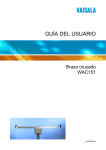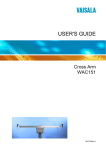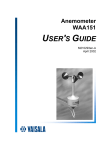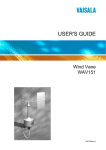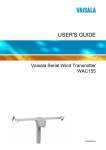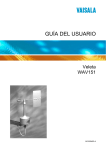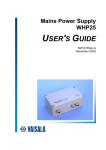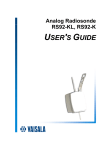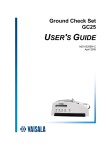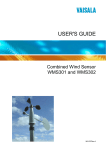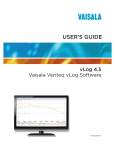Download Vaisala WAT12 User`s guide
Transcript
Analog Wind Transmitter WAT12 USER'S GUIDE M210309EN-A June 2002 PUBLISHED BY Vaisala Oyj P.O. Box 26 FIN-00421 Helsinki Finland Phone (int.):+358 9 8949 1 Fax: +358 9 8949 2227 Visit our Internet pages at http://www.vaisala.com/ © Vaisala 2002 No part of this manual may be reproduced in any form or by any means, electronic or mechanical (including photocopying), nor may its contents be communicated to a third party without prior written permission of the copyright holder. The contents are subject to change without prior notice. Please observe that this manual does not create any legally binding obligations for Vaisala towards the customer or end user. All legally binding commitments and agreements are included exclusively in the applicable supply contract or Conditions of Sale. ___________________________________________________________________ Table of Contents CHAPTER 1 GENERAL INFORMATION .......................................................5 About This Manual..................................................5 Contents of This Manual.......................................5 Version Information...............................................6 Related Manuals...................................................6 Safety .......................................................................6 General Safety Considerations.............................6 Product Related Safety Precautions .....................7 ESD Protection .....................................................7 Regulatory Compliances........................................8 Warranty ..................................................................8 CHAPTER 2 PRODUCT OVERVIEW.............................................................9 Introduction to WAT12 Analog Wind Transmitter ..............................................................9 CHAPTER 3 INSTALLATION ......................................................................11 Selecting Location ................................................11 Installation Procedure ..........................................13 Jumper Settings..................................................14 Connections........................................................16 Sensor Wiring.................................................18 Signal Output..................................................19 Powering ........................................................21 Optional Heating Power..................................22 Wiring Examples ............................................23 Mounting the Thermostat Switch ........................26 Mounting.............................................................27 Mounting WAT12 to the Top of a Pole Mast...27 Mounting Wind Sensors to WAT12 ................28 Alignment............................................................29 Verification..........................................................29 VAISALA___________________________________________________________1 User's Guide ________________________________________________________ CHAPTER 4 MAINTENANCE...................................................................... 31 Periodic Maintenance .......................................... 31 Visual Checking ................................................. 31 Testing Proper Operation................................... 31 Replacing Consumables...................................... 33 Parts List for Consumables ................................ 33 CHAPTER 5 TROUBLESHOOTING............................................................ 35 Common Problems .............................................. 35 Error Messages .................................................... 35 Getting Help .......................................................... 36 Return Instructions .............................................. 37 CHAPTER 6 TECHNICAL DATA................................................................. 39 Specifications ....................................................... 39 List of Figures Figure 1 Figure 2 Figure 3 Figure 4 Figure 5 Figure 6 Figure 7 Figure 8 Figure 9 Figure 10 Figure 11 Figure 12 Figure 13 Figure 14 Figure 15 WAT12 Analog Wind Transmitter ........................... 10 Recommended Mast Location in Open Area.......... 11 Recommended Mast Length on Top of a Building ............................................................... 12 Location of the Jumpers ......................................... 14 Jumpers for the Setting: 4 ... 20 mA, 0° ... 360°, 0 ... 51.2 m/s........................................................... 15 Jumpers for the Setting: 1 ... 5 mA, 0° ... 360°, 0 ... 76.8 m/s........................................................... 16 Jumpers for the Setting: 0 ... 10 mA, 0° ... 540°, 0 ... 51.2 m/s........................................................... 16 Cable Shield Bent over the Plastic Sleeve and O-ring .............................................................. 17 I/O Connectors ....................................................... 17 Wiring of the Sensors ............................................. 18 Typical System with 24 VDC Power Supply and 5 mA Signal Currents ...................................... 19 Wiring for High Noise Environment ........................ 20 Long Distance Wiring ............................................. 20 Long Distance Wiring with Four Wires ................... 21 Default Heating Power Connection with both Sensors .................................................................. 22 2 ______________________________________________________M210309EN-A ___________________________________________________________________ Figure 16 Basic Wiring with WAA151 and WAV151 Sensors...................................................................23 Figure 17 Wiring with WHP151 Mains Power Supply .............24 Figure 18 Wiring with WHP25 Mains Power Supply and the 252 Series Wind Sensors ..........................25 Figure 19 Mounting the Thermostat Switch inside the WAT12 Junction Box ........................................26 Figure 20 Standard Connection for Thermostat Switch ..........27 Figure 21 Mounting WAT12 to the Top of a Pole Mast ...........27 Figure 22 Installation of the Wind Sensors WAA151 and WAV151 to WAT12.................................................28 List of Tables Table 1 Table 2 Table 3 Table 4 Table 5 Manual Revisions......................................................6 Related Manuals .......................................................6 Jumper Settings for the 1 to 5 mA Current Loop.....15 I/O Connectors........................................................18 Power Line Resistance with an 24 VDC Power Supply.....................................................................21 Table 6 Jumper Selectable Reference Sources for Testing...............................................................32 Table 7 Output Values for the Jumpers in the Test Mode....32 Table 8 Available Spare Parts .............................................33 Table 9 Some Common Problems and their Remedies.......35 Table 10 WAT12 Analog Wind Transmitter Specifications ....39 VAISALA___________________________________________________________3 User's Guide ________________________________________________________ This page intentionally left blank. 4 ______________________________________________________M210309EN-A Chapter 1 ___________________________________________ General Information CHAPTER 1 GENERAL INFORMATION About This Manual This manual provides information for installing and maintaining WAT12 Analog Wind Transmitter. Contents of This Manual This manual consists of the following chapters: - Chapter 1, General Information, provides important safety, revision history, and warranty information for the product. - Chapter 2, Product Overview, introduces WAT12 Analog Wind Transmitter features. - Chapter 3, Installation, provides you with information that is intended to help you install this product. - Chapter 4, Maintenance, provides information that is needed in basic maintenance of WAT12 Analog Wind Transmitter. - Chapter 5, Troubleshooting, describes common problems, their probable causes and remedies, and provides contact information. - Chapter 6, Technical Data, provides technical data of WAT12 Analog Wind Transmitter. VAISALA___________________________________________________________5 User's Guide ________________________________________________________ Version Information Table 1 Manual Revisions Manual Code T649en-1.1 M210309EN-A Description WAT12 Analog Wind Transmitter Technical Reference. This manual, the first version of WAT12 Analog Wind Transmitter User's Guide. Supersedes the above mentioned Technical Reference. Related Manuals Table 2 Related Manuals Manual Code M210293en M210294en Manual Name WAA151 Anemometer - User's Guide WAV151 Wind Vane - User's Guide Safety General Safety Considerations Throughout the manual, important safety considerations are highlighted as follows: WARNING Warning alerts you to a serious hazard. If you do not read and follow instructions very carefully at this point, there is a risk of injury or even death. CAUTION Caution warns you of a potential hazard. If you do not read and follow instructions carefully at this point, the product could be damaged or important data could be lost. 6 ______________________________________________________M210309EN-A Chapter 1 ___________________________________________ General Information NOTE Note highlights important information on using the product. Product Related Safety Precautions WAT12 Analog Wind Transmitter delivered to you has been tested for safety and approved as shipped from the factory. Note the following precautions: WARNING Ground the product, and verify the grounding of the outdoor installation periodically to minimize shock hazard. CAUTION Do not modify the unit. Improper modification can damage the product or lead to malfunction. ESD Protection Electrostatic Discharge (ESD) can cause immediate or latent damage to electronic circuits. Vaisala products are adequately protected against ESD for their intended use. However, it is possible to damage the product by delivering electrostatic discharges when touching, removing, or inserting any objects inside the equipment housing. To make sure you are not delivering high static voltages yourself: - Handle ESD sensitive components on a properly grounded and protected ESD workbench. When this is not possible, ground yourself to the equipment chassis VAISALA___________________________________________________________7 User's Guide ________________________________________________________ before touching the boards. Ground yourself with a wrist strap and a resistive connection cord. When neither of the above is possible, touch a conductive part of the equipment chassis with your other hand before touching the boards. - Always hold the boards by the edges and avoid touching the component contacts. Regulatory Compliances WAT12 Analog Wind Transmitter is a CE compliant product. Warranty For certain products Vaisala normally gives a limited one year warranty. Please observe that any such warranty may not be valid in case of damage due to normal wear and tear, exceptional operating conditions, negligent handling or installation, or unauthorized modifications. Please see the applicable supply contract or conditions of sale for details of the warranty for each product. 8 ______________________________________________________M210309EN-A Chapter 2 ____________________________________________ Product Overview CHAPTER 2 PRODUCT OVERVIEW This chapter introduces WAT12 Analog Wind Transmitter features. Introduction to WAT12 Analog Wind Transmitter The WAT12 transmitter converts the digital data supplied by the Vaisala 151 and 252 Series wind sensors, into two industry standard analog current loops; one representing the wind speed and the other the wind direction. The current loops are suitable for connection to, for example, chart recorders, analog or digital panel meters, analog inputs of computers, or other instruments with an analog input interface. The power to the sensors is also supplied through the WAT12 transmitter. The transmitter accepts a wide range of input power, from 12 to 28 VDC. The WAT12 transmitter consists of a printed circuit board unit in a junction box and a cross arm for mounting the wind sensors, see Figure 1 on page 10. A 4-wire cable for the wind speed and direction signals and power supply is needed between the transmitter and the receiving end. The loop current is user selectable. The loops are supplied by high-side drivers with a return to the signal and power ground; thus nearly any input type can be driven. VAISALA___________________________________________________________9 User's Guide ________________________________________________________ The WAT12 transmitter provides the sensors with a throughput for optional heating power. A thermostat switch is available as an option to automatically connect the heating power in temperatures below +4 °C. 0206-041 Figure 1 WAT12 Analog Wind Transmitter The following numbers refer to Figure 1 above: 1 2 3 = Flange for mounting a Vaisala anemometer = Junction box, containing the circuit board = Flange for mounting a Vaisala wind vane 10 _____________________________________________________M210309EN-A Chapter 3 __________________________________________________ Installation CHAPTER 3 INSTALLATION This chapter provides you with information that is intended to help you install this product. Selecting Location Allow sufficient clearance for the wind sensors. Wind sensors should not be located next to a building or any other object that might affect the flow of air. 0204-040 Figure 2 Recommended Mast Location in Open Area VAISALA__________________________________________________________11 User's Guide ________________________________________________________ In general, any object of height (h) will not remarkably disturb wind measurement at a minimum distance of 10 × h. There should be at least 150 m open area in all directions from the mast. Refer to Figure 2 on page 11. 0204-041 Figure 3 Recommended Mast Length on Top of a Building The recommended minimum length (marked with the letter h in Figure 3 above) for the mast that is installed on top of a building is 1.5 times the height of the building (H). When the diagonal (W) is less than the height (H), the minimum length of the mast is 1.5 × W. 12 _____________________________________________________M210309EN-A Chapter 3 __________________________________________________ Installation Installation Procedure For installation, follow the procedure below and refer to corresponding sections for details. 1. Remove the four screws holding the cover of the WAT12 transmitter. Remove the cover. 2. Select the current output span, as well as direction and speed scaling according to the instructions in section Jumper Settings on page 14. Some examples of selecting scales and ranges are shown in Figure 5 on page 15, Figure 6 on page 16, and Figure 7 on page 16. 3. Enter the power and signal cables through the cable glands(s). For better protection against RF interference, ground the cable shield as shown in Figure 8 on page 17. 4. Connect the wires to the X2 removable screw terminal block according to Figure 11 on page 19, Figure 12 on page 20, Figure 13 on page 20, or Figure 14 on page 21. Tighten the output cable gland(s). 5. Carefully reattach the enclosure cover with the four screws. 6. Attach the unit on the top of a pole mast with the mounting clamp as shown in Figure 21 on page 27. 7. Mount the sensors onto the cross arm. Refer to Figure 22 on page 28 and the sensors' manuals. 8. Align the cross arm as instructed in section Alignment on page 29 before erecting the mast. VAISALA__________________________________________________________13 User's Guide ________________________________________________________ Jumper Settings The loop current can be selected with the on-board jumper plugs. Several output ranges, such as 0 to 20 mA, 4 to 20 mA, 0 to 10 mA, 2 to 10 mA, 0 to 5 mA, and 1 to 5 mA, are available as user configurable options, each with factory-adjusted zero and span levels. The voltage-mode signals are easily obtained by connecting a suitable resistor across the readout device's terminals. Signal full scale options are also available. For instance, a directional scale of 540° (0-360-180°), which is convenient for analog panel meters or chart recorders, can be chosen to prevent the needle or pen from oscillating across the scale with northerly winds. 0206-042 Figure 4 Location of the Jumpers The following numbers refer to Figure 4 above. 1 2 3 4 5 = = = = = X4: Test and operation X5: Output zero X7: Scaling together with X6 X8: Output span X6: Scaling together with X7 14 _____________________________________________________M210309EN-A Chapter 3 __________________________________________________ Installation For example, you can set the wind speed output from 1 to 5 mA which corresponds to speed values from 0 to 51.2 m/s and to direction values from 0 to 540 degrees. This range does not change the scaling of 360 degrees corresponding to one full turn, rather it allows to calculate the average direction during northerly winds. These settings are carried out by the jumpers of the WAT12 transmitter as described in Table 3 below. Table 3 Jumper X4 X5 X6 X7 X7 X8 Jumper Settings for the 1 to 5 mA Current Loop J5 ON J1 ON J1 ON J3 ON J5 ON J6 ON ALL OFF Description Normal operation 1 / 2 / 4 mA for 51.2 m/s 0 ... 540° 0 ... 51.2 m/s 1 ... 5 mA Some examples for selecting scales and ranges are shown in Figure 5 below, Figure 6 on page 16, and Figure 7 on page 16. 0206-043 Figure 5 Jumpers for the Setting: 4 ... 20 mA, 0° ... 360°, 0 ... 51.2 m/s VAISALA__________________________________________________________15 User's Guide ________________________________________________________ 0206-044 Figure 6 Jumpers for the Setting: 1 ... 5 mA, 0° ... 360°, 0 ... 76.8 m/s 0206-045 Figure 7 Jumpers for the Setting: 0 ... 10 mA, 0° ... 540°, 0 ... 51.2 m/s Connections The WAT12 transmitter provides the line cable entry through a gland for a cable with a diameter from 7 to 10 mm. For better protection against RF interference, bend the cable shield as illustrated in Figure 8 on page 17. 16 _____________________________________________________M210309EN-A Chapter 3 __________________________________________________ Installation 0206-046 Figure 8 Cable Shield Bent over the Plastic Sleeve and O-ring The WAT12 transmitter has three I/O connectors as listed in Table 4 on page 18. For the location of the connectors, refer to Figure 9 below. 0206-047 Figure 9 I/O Connectors The following numbers refer to Figure 9 above. 1 2 3 = X1: For the anemometer cable = X2: For the power and signal cable = X3: For the wind vane cable VAISALA__________________________________________________________17 User's Guide ________________________________________________________ Table 4 Connector X1 X2 X3 I/O Connectors Description Plug-in connector with screw terminals (5 pcs) for the anemometer cable. Maximum wire cross section area is 1.5 mm2. Plug-in connector with screw terminals (8 pcs) for the power and signal cable. Maximum wire cross section area is 1.5 mm2. Plug-in connector with screw terminals (11 pcs) for the wind vane cable. Maximum wire cross section area is 1.5 mm2. Sensor Wiring The transmitter connects to the wind sensors with the crossarm's standard cables through two cable glands. Through these cables the WAT12 transmitter both feeds the sensor power and receives the wind data. Plug-in type screw terminal connectors are provided both for the sensor cables and the output line cable. 0206-048 Figure 10 Wiring of the Sensors 18 _____________________________________________________M210309EN-A Chapter 3 __________________________________________________ Installation The following numbers refer to Figure 10 on page 18. 1 2 3 = Anemometer cable = Glands for power and signal cables = Wind vane cable Signal Output The signal output provides two analog current loops, direction and speed, with sourcing drivers with an o/p driving voltage 10.5 V typically and an o/p resistance of 57 Ω. The loops return to the common ground for power and signal. The signal and sensor power outputs are also current limited. Typically, only a 4-wire shielded cable is required for the line between the WAT12 transmitter and the receiving end. Two of the four wires provide the operating power for the system. The other two are for the current source outputs from the WAT12 transmitter; one delivering the speed signal and the other the direction signal. The two readout devices are wired each across the respective current source terminal (+) and the negative terminal of the power supply (-). Refer to Figure 11 below for a typical system with a 24 VDC power supply and the 5 mA signal currents. 0206-049 Figure 11 Typical System with 24 VDC Power Supply and 5 mA Signal Currents VAISALA__________________________________________________________19 User's Guide ________________________________________________________ Figure 12 below illustrates wiring for high noise environment. It is essential to ground the cable also at the power supply. 0206-050 Figure 12 Wiring for High Noise Environment Figure 13 below illustrates wiring for long distance with the 5 mA loop current. Note the maximum resistance values for both the power and signal leads. 0206-051 Figure 13 Long Distance Wiring Figure 14 on page 21 illustrates 4-wire wiring for long distance with a 48 VDC power supply. CAUTION A source resistance, over 1000Ω, must be used for dropping VIN to an acceptable level, because if VIN exceeds 28 VDC, the transmitter may be damaged permanently. 20 _____________________________________________________M210309EN-A Chapter 3 __________________________________________________ Installation 0206-052 Figure 14 Long Distance Wiring with Four Wires Powering The WAT12 transmitter accepts a wide range of input power, from 12 to 28 VDC. When the 5 mA loop current is selected, the total current consumption is less than 40 mA including the sensors and the loop current. The low current consumption enables to remotely supply the operating power from a distance of several kilometers, even through private or leased telephone lines. The maximum power line resistance depends on the supply voltage and the loop current selection. For an example with an 24 VDC power supply, refer to and to Figure 11 on page 19. Table 5 Power Line Resistance with an 24 VDC Power Supply Loop Current, mA 5 10 20 Power Line Resistance, Ω 360 310 250 For other powering options, refer to Figure 12 on page 20, Figure 13 on page 20, and Figure 14 above. VAISALA__________________________________________________________21 User's Guide ________________________________________________________ The power line is protected against the wrong polarity. Transient protection is accomplished with VDRs, series inductors and resistors, and transient zener diodes on both the power line and each I/O line. Optional Heating Power The WAT12 transmitter also provides the sensors with a throughput for optional heating power. The heating power connection requires an extra pair of wires. Since the heating elements, in the shafts of the WAA151 and WAV151 sensors, typically consume some 500 mA, the heating power is most conveniently supplied from a local power source. A thermostat switch is available for automatic connection of the heating power in temperatures below +4 °C. The optional heating power requirement is 20 VAC or VDC, and 500 mA for both WAV151 and WAA151 sensors. The sensors can be connected in series, when a 40 V power supply providing 500 mA is required. Alternatively, the sensors can be connected in parallel, when a 20 V power supply providing 1 A is required. For the default connection, refer to Figure 15 below. 0206-053 Figure 15 Default Heating Power Connection with both Sensors 22 _____________________________________________________M210309EN-A Chapter 3 __________________________________________________ Installation Wiring Examples Refer to Figure 16 below for the basic wiring, when the WAA151 and WAV151 wind sensors are connected to the WAT12 transmitter. 0206-054 Figure 16 Basic Wiring with WAA151 and WAV151 Sensors Figure 17 on page 24 illustrates the wiring with WHP151 Mains Power Supply. Figure 18 on page 25 illustrates the wiring with WHP25 Mains Power Supply and the 252 series wind sensors. NOTE An expansion connector and discrete joining wires are included in the WAA252 accessories. VAISALA__________________________________________________________23 User's Guide ________________________________________________________ 0206-055 Figure 17 Wiring with WHP151 Mains Power Supply 24 _____________________________________________________M210309EN-A Chapter 3 __________________________________________________ Installation 0206-056 Figure 18 Wiring with WHP25 Mains Power Supply and the 252 Series Wind Sensors VAISALA__________________________________________________________25 User's Guide ________________________________________________________ Mounting the Thermostat Switch The thermostat switch connects at +4 °C (+3 °C) and disconnects at +11 °C (+3 °C). For mounting, refer to Figure 19 below. For standard wiring, refer to Figure 20 on page 27. 0206-057 Figure 19 Mounting the Thermostat Switch inside the WAT12 Junction Box The following numbers refer to Figure 19 above. 1 2 3 CAUTION = Thermostat switch = Regulator = Wires The thermostat switch (number 1 in Figure 19 above) must not touch the regulator (2). 26 _____________________________________________________M210309EN-A Chapter 3 __________________________________________________ Installation 0206-058 Figure 20 Standard Connection for Thermostat Switch Mounting Mounting WAT12 to the Top of a Pole Mast Figure 21 below illustrates mounting of the WAT12 transmitter to the top of a Ø 60 mm pole mast, with the standard mounting clamp. The arrow on the cover of the junction box must point to north. 0206-059 Figure 21 Mounting WAT12 to the Top of a Pole Mast VAISALA__________________________________________________________27 User's Guide ________________________________________________________ WARNING A long cable between different units (sensors, transmitters, power supplies, and displays) can cause a lethal surge voltage, if a lightning strikes in the vicinity. Always ground the mast equipment case close to the mast with a short and low-resistance cable. Mounting Wind Sensors to WAT12 0110-005 Figure 22 Installation of the Wind Sensors WAA151 and WAV151 to WAT12 The following numbers refer to Figure 22 above: 1 2 3 4 5 6 7 8 = = = = = = = = WAA151 Cup assembly WAV151 Tail assembly Cross arm WAT12 Connector Mounting flange SOUTH NORTH 28 _____________________________________________________M210309EN-A Chapter 3 __________________________________________________ Installation Alignment After mounting the WAT12 transmitter to the mast, check that the WAV151 end of the cross arm is pointing to north with the required accuracy, see Figure 21 on page 27. For ensuring correct assemblage after aligning the WAT12, you can mount the sensors on it only in one way. Verification If the signal cable from the WAT12 transmitter is connected to the data collection system and the system is powered up, check that the wind readings react correctly. For testing the anemometer, rotate the cups manually. For testing the wind vane, hold the vane in a few fixed angles and verify data. VAISALA__________________________________________________________29 User's Guide ________________________________________________________ This page intentionally left blank. 30 _____________________________________________________M210309EN-A Chapter 4 ________________________________________________ Maintenance CHAPTER 4 MAINTENANCE This chapter provides information that is needed in basic maintenance of WAT12 Analog Wind Transmitter. Periodic Maintenance Visual Checking Check every 1 to 2 years that the printed circuit board is not corrored. Testing Proper Operation For easy testing and adjustment, reference signals are provided for the two output channels. For instance, by inserting a jumper plug, an output can be forced to the full scale or zero level. Hence a readout device can be easily adjusted to comply with the transmitter output. Inside the transmitter box there is an instruction label, showing all the useful jumper combinations for output scale, measurement range, and testing. VAISALA__________________________________________________________31 User's Guide ________________________________________________________ Table 6 Jumper Selectable Reference Sources for Testing Variable Direction Speed Reference Signal Alternatives 000° / 008° / 357° 0.0 m/s / 0.8 m/s / 51.2 m/s Follow the procedure below to test the WAT12 transmitter functionality with the reference signals: 1. Remove the four screws holding the cover of the WAT12 transmitter. Remove the cover. 2. Remove the jumper J5 from the jumper block X4 to enable the test stage. 3. Select one of the direction and speed alternatives with jumpers J1, J2, J3, and J4, refer to Table 7 below. For the location of the jumper block X4, see Figure 4 on page 14. Table 7 Jumper J1 ON J2 ON J3 ON J4 ON All open CAUTION Output Values for the Jumpers in the Test Mode Output Value 51.2 m/s 0.8 m/s 357° 008° 0 m/s and 000° 4. Verify the readings with the data collecting system at the receiving end. 5. To end the test stage, reattach the jumper J5 to the jumper block X4. 6. After a successful test, carefully reattach the enclosure cover with the four screws. Do not try to adjust the transmitter scaling from the sealed potentiometers of the transmitter. 32 _____________________________________________________M210309EN-A Chapter 4 ________________________________________________ Maintenance Replacing Consumables When replacing the component board, read carefully section ESD Protection on page 7. When replacing the thermostat switch, refer to section Mounting the Thermostat Switch on page 26. Parts List for Consumables Table 8 Available Spare Parts Spare Part Order Code Component Board for WAT12 16637WA Thermostat switch 16923WA VAISALA__________________________________________________________33 User's Guide ________________________________________________________ This page intentionally left blank. 34 _____________________________________________________M210309EN-A Chapter 5 ______________________________________________ Troubleshooting CHAPTER 5 TROUBLESHOOTING This chapter describes common problems, their probable causes and remedies, and provides contact information. Common Problems Table 9 Some Common Problems and their Remedies Problem Data is not received by the data collecting system. Shaft heating of the sensors is not working. Probable Cause Improper or loose connections Improper or loose connections Heating is not connected. The thermostat switch is failing. Remedy Check wiring and tighten the screw terminals. Check wiring and tighten the screw terminals. Check the connections. Replace the thermostat switch. Error Messages If the wind speed or direction sensor is removed (output current is 0), the values in the messages are replaced by slashes and the I/O error bit of status is set to 1. VAISALA__________________________________________________________35 User's Guide ________________________________________________________ Getting Help For technical questions or for comments on the manuals, contact the Vaisala technical support: E-mail [email protected] Telephone +358 9 8949 2789 Fax +358 9 8949 2790 36 _____________________________________________________M210309EN-A Chapter 5 ______________________________________________ Troubleshooting Return Instructions If the product needs repair, please follow the instructions below to speed up the process and avoid extra costs. 1. Read the warranty information. 2. Write a Problem Report with the name and contact information of a technically competent person who can provide further information on the problem. 3. On the Problem Report, please explain: - What failed (what worked / did not work)? - Where did it fail (location and environment)? - When did it fail (date, immediately / after a while / periodically / randomly)? - How many failed (only one defect / other same or similar defects / several failures in one unit)? - What was connected to the product and to which connectors? - Input power source type, voltage and list of other items (lighting, heaters, motors etc.) that were connected to the same power output. - What was done when the failure was noticed? 4. Include a detailed return address with your preferred shipping method on the Problem Report. 5. Pack the faulty product using an ESD protection bag of good quality with proper cushioning material in a strong box of adequate size. Please include the Problem Report in the same box. 6. Send the box to: Vaisala Oyj SSD Service Vanha Nurmijärventie 21 FIN-01670 Vantaa Finland VAISALA__________________________________________________________37 User's Guide ________________________________________________________ This page intentionally left blank. 38 _____________________________________________________M210309EN-A Chapter 6 _______________________________________________Technical Data CHAPTER 6 TECHNICAL DATA This chapter provides technical data of WAT12 Analog Wind Transmitter. Specifications Table 10 WAT12 Analog Wind Transmitter Specifications Property Equipment type Description / Value Digital-to-analog current loop converter for Vaisala wind sensors Signal input: wind direction 6-bit parallel GRAY code (optionally 7 bits) wind speed Pulse frequency 0 ... 750 Hz Input operating power 12 ... 28 VDC, 30 mA Output sensor power on-board regulated to 10.7 VDC typically Output signals Two analog current loops, one for direction, one for speed. High-side drivers; the loops return to the common signal and power ground. Loop driving voltage 10 V typically. Loop current options, 0 ... 5 mA jumper selectable and 1 ... 5 mA common for both 0 ... 10 mA channels 2 ... 10 mA 0 ... 20 mA 4 ... 20 mA VAISALA__________________________________________________________39 User's Guide ________________________________________________________ Property Signal cable Max. loop resistance (incl. cable and receiver's input resistance) Full scale options: for direction for speed Resolution: for direction for speed Updating interval: for direction for speed Output accuracy Accuracy with loop resistance: RL= 100 Ω RL= 20 ... 2000 Ω Pulse-mode power feed: to the vane to the anemometer Testing references: for direction for speed Dimensions: printed circuit board junction box Cross arm length Ingress protection Mounting Weight Material: cross arm junction box Temperature range: operating storage Humidity Description / Value 4 wires minimum (VIN+, VIN-, DOP, SOP) 1800 ohm for 5 mA loop 900 ohm for 10 mA loop 450 ohm for 20 mA loop 0 ... 360° / 0 ... 540° 0 ... 51.2 m/s / 0 ... 76.8 m/s ±2.8° 0.1 m/s 8 times a second (with no averaging) Once a second (averaged over previous 1 s period) Better than 1 % of full scale ±0.2 % of full scale at +25 °C ±0.8 % of full scale at full temp. range Nominally 490 µs wide pulse, applied every 125 ms Nominally 70 µs wide pulse, applied every 0.49 ms . 000° / 008° / 357° 0.0 m/s / 0.8 m/s / 51.2 m/s 2 114 × 69 mm 125 (w) × 80 (h) × 57 (d) mm 800 mm IP65 To a Ø 60 mm pole mast 1.5 kg AI anodized AI painted gray -55 ... +55 °C -60 ... +70 °C 0 ... 100 %RH 40 _____________________________________________________M210309EN-A










































